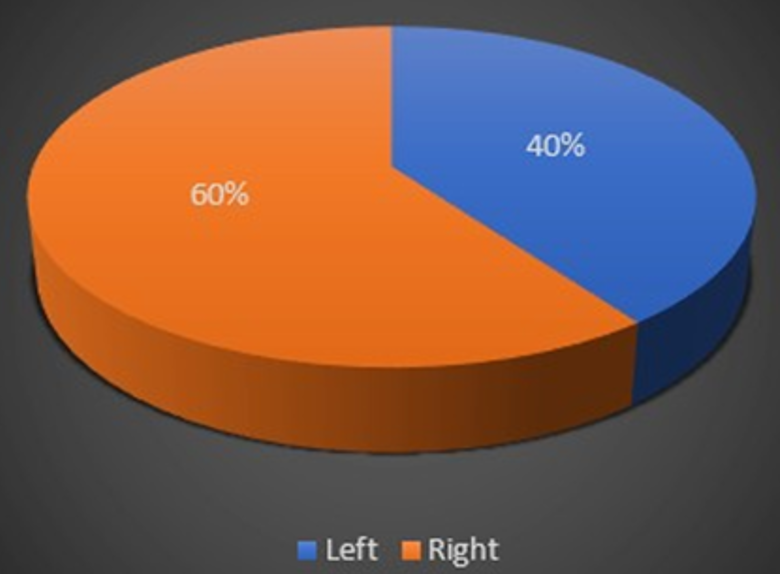Abstract
Fractures of the distal femur are high-velocity injuries and are associated with factors such as fracture comminution and osteoporosis, especially in elderly individuals which are quite challenging to manage. Various implants and techniques are available for the surgical management of these fractures. This study was performed to evaluate the functional outcome of these fractures following ORIF (Open reduction and internal fixation) with the DFLP (Distal femoral locking plate). Thirty patients with distal femoral intraarticular fractures who presented between February 2013 to February 2016 were managed by ORIF with DFLP and were followed up for three years. Functional evaluation was performed using the Neers scoring system. The average age of the patients was 38.06 years ranging from 22 to 64 years. There were twenty-one males, and nine females seen in our study with the right side being more commonly affected. We achieved a 100% union rate in our series with the meantime to fracture union being 12.86 weeks. We had excellent results in 65% of patients and satisfactory results in 35% of patients with minimal complications. ORIF with the DFLP is a unique biological fixation option in intraarticular fractures of the distal femur, and it provides for reasonable rates of fracture union and an excellent functional outcome with minimal complications.
Full text article
References
Bolhofner, B. R., Carmen, B., Clifford, P. 1996. The Results of Open Reduction and Internal Fixation of Distal Femur Fractures Using a Biologic (Indirect) Reduction Technique. Journal of Orthopaedic Trauma, 10(6):372–377.
Cantu, R. V., Koval, K. J. 2006. The Use of Locking Plates in Fracture Care. Journal of the American Academy of Orthopaedic Surgeons, 14(3):183–190.
Crist, B. D., Rocca, G. J. D., Murtha, Y. M. 2008. Treatment of Acute Distal Femur Fractures. Orthopedics, 31(7):681–690.
Fankhauser, F., Gruber, G., Schippinger, G., Boldin, C., Hofer, H. P., Grechenig, W., Szyszkowitz, R. 2004. Minimal-invasive treatment of distal femoral fractures with the LISS (Less Invasive Stabilization System): a prospective study of 30 fractures with a follow up of 20 months. Acta Orthop Scand, 75(1):56–60.
Galal, S. 2017. Dynamic locked plating for fixation of distal femur fractures using near cortical over-drilling: Preliminary results of a prospective observational study. Journal of Clinical Orthopaedics and Trauma, 8(3):215–219.
Greiwe, R. M., Archdeacon, M. T. 2007. Locking plate technology: current concepts. J Knee Surg, 20:50– 55.
Higgins, T. F. 2007. Distal femoral fractures. J Knee Surg, 20:56–66.
Martinet, O., Cordey, J., Harder, Y., Maier, A., Bühler, M., Barraud, G. E. 2000. The epidemiology of fractures of the distal femur. Injury, 31:62–94.
Schmidt, U., Penzkofer, R., Bachmaier, S., Augat, P. 2013. Implant Material and Design Alter Construct Stiffness in Distal Femur Locking Plate Fixation: A Pilot Study. Clinical Orthopaedics and Related Research, 471(9):2808–2814.
Stewart, M. J., Sisk, T. D., Wallace, S. L. 1966. Fractures of the Distal Third of the Femur. The Journal of Bone & Joint Surgery, 48(4):784–807.
Toro, G., Calabrò, G., Toro, A., De Sire, A., Iolascon, G. 2015. Locking plate fixation of distal femoral fractures is a challenging technique: a retrospective review. Clin Cases Miner Bone Metab, 12(Supple 1):55–58.
Vallier, H. A., Immler, W. 2012. Comparison of the 95-Degree Angled Blade Plate and the Locking Condylar Plate for the Treatment of Distal Femoral Fractures. Journal of Orthopaedic Trauma, 26(6):327–332.
Ziran, B., Rohde, R. S., Wharton, A. R. 2002. Lateral and anterior plating of intra-articular distal femoral fractures treated via an anterior approach. International orthopaedics, 26(6):370– 373.
Zlowodzki, M., Williamson, S., Cole, P. A., Zardiackas, L. D., Kregor, P. J. 2004. Biomechanical Evaluation of the Less Invasive Stabilization System, Angled Blade Plate, and Retrograde Intramedullary Nail for the Internal Fixation of Distal Femur Fractures. Journal of Orthopaedic Trauma, 18(8):494–502.
Authors

This work is licensed under a Creative Commons Attribution-NonCommercial-NoDerivatives 4.0 International License.

